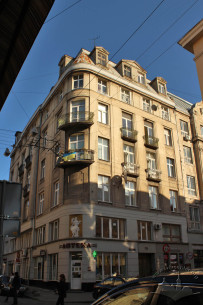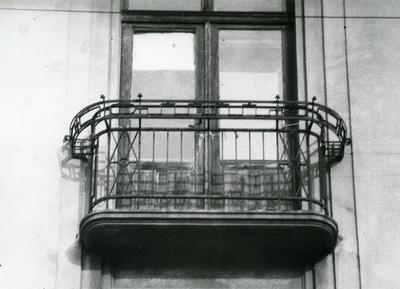Vul. Halytska, 19 – residential building ID: 2333
The corner house on Halytska street 18 and Brativ Rohatyntsiv street 6-8 (old conscription numbers 416, 322, 323, new conscription numbers 294) was built in 1916. It was constructed in the classic Art Nouveau style under a project drawn up by architect Jan Schulz for the Galician joint stock merchant (commercial) bank. According to the resolution of the Lviv regional executive committee number 393 dated 22 November 1988, the house on Valova street 5 was entered into the local register of monuments under protection number 877.
Story
1791 – a three-story stone house is constructed on the emphyteutic ground in place of the Halytska gate’s dismantled tower and walls.
1884 – during a reconstruction the residential house façade is designed in the Neo-Renaissance style.
1913 – a project of the Galician joint stock merchant bank is drawn up (architects Alfred Zachariewich, Józef Sosnowski); the project was never carried out.
1914, 1916 – an additional project is drawn up and approved (architect Jan Schulz); the project has been implemented.
1930s – J. Wywiórski arranges a pharmacy on the ground floor of the house.
The former Galician joint stock merchant bank building (old conscription numbers 416, 322, 323, new conscription numbers 294), the corner house from Brativ Rohatyntsiv street 6-8 was built in place of a stone house that was constructed in the late eighteenth century and stood on three building plots. The first stone house was built here, on the so-called emphyteutic (that is, belonging to the town) ground by a cobbler named Szymon Chmarowski in 1791. The town placed the ground at Chmarowski’s disposal provided that within two years he would construct a three-story stone house there in accordance with a project approved by the building direction. The town tabula register reports that this three-story stone house was erected in place of the former Halytska gate with towers and town walls. The house built by cobbler Chmarowski, with some small changes in the architectural décor, stood there till the early twentieth century. On a drawing dated 1884 one can see that its three-story façade was designed in the Neo-Renaissance style. The present-day house was constructed for the Galician joint stock merchant bank. Its project was drawn up by known Lviv architects Alfred Zachariewicz and Józef Sosnowski and approved on 2 December 1913. An additional project, which corresponds to the present-day condition of the house, was drawn up by architect Jan Schulz in January-February of 1914 and approved on 22 December 1916. The same architect managed the construction. Before the project was approved, the Magistrate demanded that the house façade resemble the façade of the neighbouring building number 21 built by doctor Theodor Bałłaban; this demand was taken into consideration. There were a few apartments in the bank building; dentist Abram Berger, tailor Segal Lieber, a linen shop owner Stefan Starzewski lived there in 1913. In the 1930s, a pharmacy was arranged by J. Wywiurski on the ground floor of the house; the entrance was made at the corner. The pharmacy continued to function; in 1980, the Hygieia relief made by sculptor Roman Oprysk was installed over the entrance at the corner.
Architecture
The corner house has six axes from Brativ Rohatyntsiv street and four axes from Halytska street, with the entrance from the latter. It has six stories and attic premises in the roof. It is built of brick, plastered and designed in the classic Art Nouveau style. The façades are divided vertically by feebly marked lesenes. The first two stories are accentuated by large shop windows; the ground floor is made in imitation of rusticated stonework; the last floor is accentuated by a pediment. The façade facing Brativ Rohatyntsiv street is accentuated by a two-axis central partition that have little balconies with simple railings at the level of the fourth and fifth floors. The same balconies were made on the two central axes from the side of Halytska street. The rounded corner is accentuated by big balconies. A Hygieia relief is installed over the corner entrance to the pharmacy.
People
Abraham Berger –
a dentist who lived in the building on Halytska street 19.
Alfred Władysław Zachariewicz –
a known Lviv architect who drew up a project of the bank in 1913; the
project was not carried out.
Roman Oprysk –
a sculptor who made the Hygieia relief.
Segal Lieber –
a tailor who lived in the building on Halytska street 19.
Stefan Starzewski –
a linen shop owner who lived in the building on Halytska street 19.
Teodor Bałłaban –
a doctor who owned the neighbouring house (number 21).
Szymon Chmarowski –
a cobbler who built the first stone house on the place where the
present-day building stands in 1791.
Józef Sosnowski –
a known Lviv architect who drew up a project of the bank in 1913; the
project was not carried out.
J. Wywiórski –
the owner of a pharmacy situated in the building on Halytska street
19.
Jan Schulz -
a known Lviv architect who drew up a project of the bank in 1914; the
project was carried out.
Sources
- State Archive of Lviv Oblast (DALO) 2/1/2118. The file was renamed: DALO 2/1/1985. URL: https://e.archivelviv.gov.ua/file-viewer/228764#file-839970
- Central State Historical Archive of Ukraine in Lviv (CDIAL) 166/1/8:145.
- CDIAL 166/1/897:153, №89.
- CDIAL 166/1/903:87, №33.
- Ksіęga adresowa król. stoł. miasta Lwowa (Lwów, 1913).
- Володимир Вуйцик, Leopolitana II (Львів: Класика, 2012).
Citation
Oksana Boyko, Vasyl Slobodyan. "Vul. Halytska, 19 – residential building", Transl. by Andriy Masliukh, Lviv Interactive, (Center for Urban History, 2014). URL: https://lia.lvivcenter.org/en/objects/halytska-19/






















